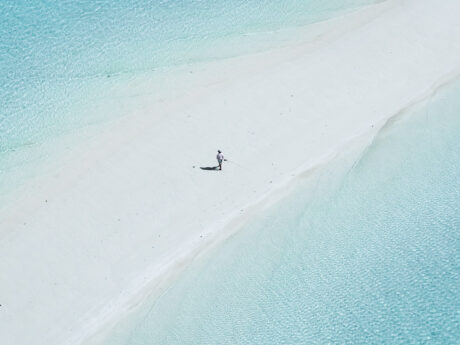
OK, you’ve decided that you’re going to chase some bonefish on foot. Want to make sure you actually catch one? Read this.
Wading for bonefish is both thrilling and humbling. On a good flat, when you spot a bonefish, on a flat is like the introduction of “In the Air Tonight.” Starting slow, while building to eclectic tension from silence until then, the strike of drums drops as you strip set. As exciting as it is, here’s the catch: many anglers blow their first few shots because they were not careful on the approach. Bonefish spook easily from poor wading technique—long before the cast ever matters. Flats wading is the quiet skill behind every great bonefishing story.
So in this post, we share 5 practical, hard-earned tips that’ll help you move smarter, fish calmer, and finally stay invisible in the shallows.
- Walk quietly. Bonefish are very sensitive to noise and vibration from a long way away. If you’re on a flat with a hard bottom, step softly – landing on the balls of your feet instead of your heels. And don’t ‘slosh’ your feet through the water – pick your foot up vertically, step forward, and step down. It makes a significant difference.
- Let your line loop behind you in the water. The best way to manage fly line while wading is the simplest. Strip off a length of line that you’re comfortable casting. Leave enough line out of your rod tip that your rod will load well when you start casting (probably 12-15 feet). When you’re wading, just let that extra line loop behind you in the water. When you see a fish, quietly pull that long loop in the water into a pile at your feet. This way, it’ll have less drag when you cast, allowing you to shoot your cast more smoothly. Stripping off a bunch of the line isn’t necessarily helpful and can cause problems with line management. So be mindful of how much line you strip off. Make sure it’s within the range of how far you can cast.
- Walk where they came from. When you’re wading, you should generally be set up so the fish are swimming towards you. Not always, but most of the time, bonefish tend to swim a particular path in a flat. When you see a fish swimming at you, don’t just look at where he is – look at where he came from. Chances are, he’s got friends behind him, taking the same path he did. Walk there.
- Wear good boots. In fisheries like ours on South Andros, there are some really huge flats with all kinds of bottoms, from hard sand to muck to nasty limestone. You can get out of the boat and literally walk for hours, so it’s essential to have good footwear. No, not an old pair of All-Stars. No, not a pair of ‘flats sandals’. A good, solid pair of boots designed for wading on the flats, like the Simms Flats Sneakers, and don’t forget about socks! A pair of good socks is a game-changer. We realize this sounds counterintuitive, but a pair of wool (not too thick) socks pairs well with saltwater wading boots.
- There’s more where that came from. One of the great things about bonefish is that they tend to be plentiful. When a fish swims by, make your best shot. If he doesn’t eat, try again once, or maybe twice. But then don’t waste your time! Shooting at a fish that’s swimming away is a very, very low percentage endeavor. Keep walking in the direction that the fish came from – you’re betting on finding a new target.
Visit The Deneki Family of Lodges: Chase Adventure, Live The Legend
Leave a Reply